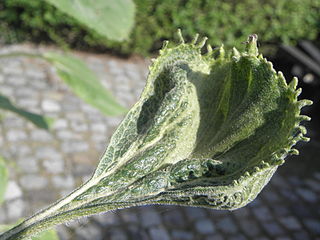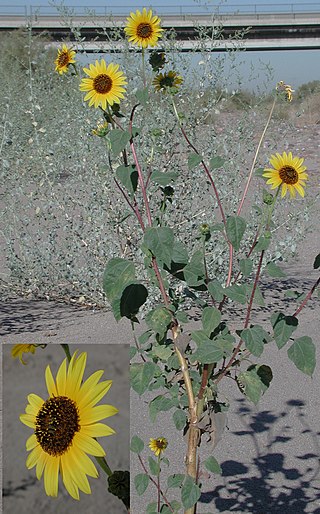Related Research Articles

The common sunflower is a species of large annual forb of the genus Helianthus. It is commonly grown as a crop for its edible oily seeds. Apart from cooking oil production, it is also used as livestock forage, as bird food, in some industrial applications, and as an ornamental in domestic gardens. Wild H. annuus is a widely branched annual plant with many flower heads. The domestic sunflower, however, often possesses only a single large inflorescence atop an unbranched stem.
The Monsanto Company was an American agrochemical and agricultural biotechnology corporation founded in 1901 and headquartered in Creve Coeur, Missouri. Monsanto's best known product is Roundup, a glyphosate-based herbicide, developed in the 1970s. Later, the company became a major producer of genetically engineered crops. In 2018, the company ranked 199th on the Fortune 500 of the largest United States corporations by revenue.
Agricultural biotechnology, also known as agritech, is an area of agricultural science involving the use of scientific tools and techniques, including genetic engineering, molecular markers, molecular diagnostics, vaccines, and tissue culture, to modify living organisms: plants, animals, and microorganisms. Crop biotechnology is one aspect of agricultural biotechnology which has been greatly developed upon in recent times. Desired trait are exported from a particular species of Crop to an entirely different species. These transgene crops possess desirable characteristics in terms of flavor, color of flowers, growth rate, size of harvested products and resistance to diseases and pests.

Genetically modified foods, also known as genetically engineered foods, or bioengineered foods are foods produced from organisms that have had changes introduced into their DNA using various methods of genetic engineering. Genetic engineering techniques allow for the introduction of new traits as well as greater control over traits when compared to previous methods, such as selective breeding and mutation breeding.

Helianthus is a genus comprising about 70 species of annual and perennial flowering plants in the daisy family Asteraceae commonly known as sunflowers. Except for three South American species, the species of Helianthus are native to North America and Central America. The best-known species is the common sunflower. This and other species, notably Jerusalem artichoke, are cultivated in temperate regions and some tropical regions, as food crops for humans, cattle, and poultry, and as ornamental plants. The species H. annuus typically grows during the summer and into early fall, with the peak growth season being mid-summer.

Genetically modified crops are plants used in agriculture, the DNA of which has been modified using genetic engineering methods. Plant genomes can be engineered by physical methods or by use of Agrobacterium for the delivery of sequences hosted in T-DNA binary vectors. In most cases, the aim is to introduce a new trait to the plant which does not occur naturally in the species. Examples in food crops include resistance to certain pests, diseases, environmental conditions, reduction of spoilage, resistance to chemical treatments, or improving the nutrient profile of the crop. Examples in non-food crops include production of pharmaceutical agents, biofuels, and other industrially useful goods, as well as for bioremediation.

Sorghum bicolor, commonly called sorghum and also known as great millet, broomcorn, guinea corn, durra, imphee, jowar, or milo, is a grass species cultivated for its grain, which is used for food for humans, animal feed, and ethanol production. Sorghum originated in Africa, and is now cultivated widely in tropical and subtropical regions. Sorghum is the world's fifth-most important cereal crop after rice, wheat, maize, and barley, with 61,000,000 metric tons of annual global production in 2021. S. bicolor is typically an annual, but some cultivars are perennial. It grows in clumps that may reach over 4 metres (13 ft) high. The grain is small, ranging from 2 to 4 millimetres in diameter. Sweet sorghums are sorghum cultivars that are primarily grown for forage, syrup production, and ethanol; they are taller than those grown for grain.

The National University of the Littoral is a public university in Argentina. It is based in Santa Fe, the capital of Santa Fe Province. It has colleges and other academic facilities in Esperanza, Reconquista and Gálvez, also in Santa Fe Province.

Plasmopara halstedii is a plant pathogen infecting sunflowers. The species is one of many pathogens commonly referred to as downy mildew. P. halstedii originated in North America.
Phoma macdonaldii is a plant pathogenic fungus that is a major causal force for the disease Phoma Black Stem.
Drought tolerance is the ability by which a plant maintains its biomass production during arid or drought conditions. Some plants are naturally adapted to dry conditions, surviving with protection mechanisms such as desiccation tolerance, detoxification, or repair of xylem embolism. Other plants, specifically crops like corn, wheat, and rice, have become increasingly tolerant to drought with new varieties created via genetic engineering. From an evolutionary perspective, the type of mycorrhizal associations formed in the roots of plants can determine how fast plants can adapt to drought.
Roundup Ready is the Monsanto trademark for its patented line of genetically modified crop seeds that are resistant to its glyphosate-based herbicide, Roundup.
Genetically modified wheat is wheat that has been genetically engineered by the direct manipulation of its genome using biotechnology. As of 2020, no GM wheat is grown commercially, although many field tests have been conducted, with one wheat variety, Bioceres HB4 Wheat, obtaining regulatory approval from the Argentinean government.

A genetically modified soybean is a soybean that has had DNA introduced into it using genetic engineering techniques. In 1996, the first genetically modified soybean was introduced to the U.S. by Monsanto. In 2014, 90.7 million hectares of GM soybeans were planted worldwide, this is almost 82% of the total soybeans cultivation area.
BASF Plant Science is a subsidiary of BASF in which all plant biotechnology activities are consolidated. The company was founded in 1998 and employs approximately 700 people at 6 different locations worldwide. The headquarters of BASF Plant Science is located in Research Triangle Park and has research sites in the US, Canada, and Europe. The company mainly develops genetically modified seeds at these locations.

Plant breeding is the science of changing the traits of plants in order to produce desired characteristics. It has been used to improve the quality of nutrition in products for humans and animals. The goals of plant breeding are to produce crop varieties that boast unique and superior traits for a variety of applications. The most frequently addressed agricultural traits are those related to biotic and abiotic stress tolerance, grain or biomass yield, end-use quality characteristics such as taste or the concentrations of specific biological molecules and ease of processing.
Mutation breeding, sometimes referred to as "variation breeding", is the process of exposing seeds to chemicals, radiation, or enzymes in order to generate mutants with desirable traits to be bred with other cultivars. Plants created using mutagenesis are sometimes called mutagenic plants or mutagenic seeds.

Helianthus anomalus, the western sunflower, is a species of plants in the family Asteraceae, found in the southwestern United States.
HB4 wheat is a type of wheat that has been genetically modified by introducing sunflower genes, with the objective of improving crop productivity. Wheat, along with corn and soybeans, constitute the basis of world food, and different scientific research was focused on improving its productivity. The improvements in food production achieved in the 90's agricultural production could equal the food demand of the world population, thanks to different technological improvements.
References
- 1 2 "Female #FoodHeroes: Raquel Lía Chan". CropLife International. Retrieved 2020-03-04.
- ↑ Feeney, Roberto (2014). "Bioceres: Ag Biotechnology from Argentina" (PDF).
- ↑ "Argentina to Release Drought and Salt Tolerant Soybean". Crop Biotech Update. Retrieved 2020-03-04.
- ↑ "World Intellectual Property Organization". www.facebook.com. Retrieved 2020-03-04.
- ↑ YurkevichResponder, Rafael. "Raquel Chan: "No nos mandaron a lavar los platos, pero estamos en ese camino" – Agencia TSS" (in European Spanish). Retrieved 2020-03-04.
- ↑ EL UNIVERSO. "Ecuatoriana entre las 10 científicas más destacadas de Latinoamérica". El Universo. Retrieved 4 November 2015.
- 1 2 3 4 5 "Raquel Lia Chan". Elsevier. Retrieved 4 November 2015.
- ↑ "Raquel Chan. Quién es y cómo piensa la mujer que busca alimentar al mundo y se merece un Premio Nobel". LA NACION (in Spanish). 2022-01-15. Retrieved 2022-09-22.
- ↑ Blankstein, A.M.; Noguera, P. (2015). Excellence Through Equity: Five Principles of Courageous Leadership to Guide Achievement for Every Student. SAGE Publications. ISBN 978-1-4833-9285-1 . Retrieved 2015-11-04.
- ↑ "10 mujeres que lideran la ciencia en América Latina". BBC Mundo. Retrieved 4 November 2015.
- ↑ "Drought-resistant Argentine soy raises hopes, concerns". phys.org. Retrieved 4 November 2015.
- ↑ Cerier, Steven (2018-09-06). "Argentina and GMOs: Exploring the nation's long relationship with biotech crops". Genetic Literacy Project. Retrieved 2020-03-04.
- ↑ Fundación Konex (2 May 2023). "Raquel Chan: Premio Konex 2013 y 2023 - Ciencia y Tecnología". fundacionkonex.org (in Spanish). Retrieved 2023-05-15.
- ↑ "inventor:"Lia Raquel Chan" - Google Search". www.google.com. Retrieved 2020-03-04.